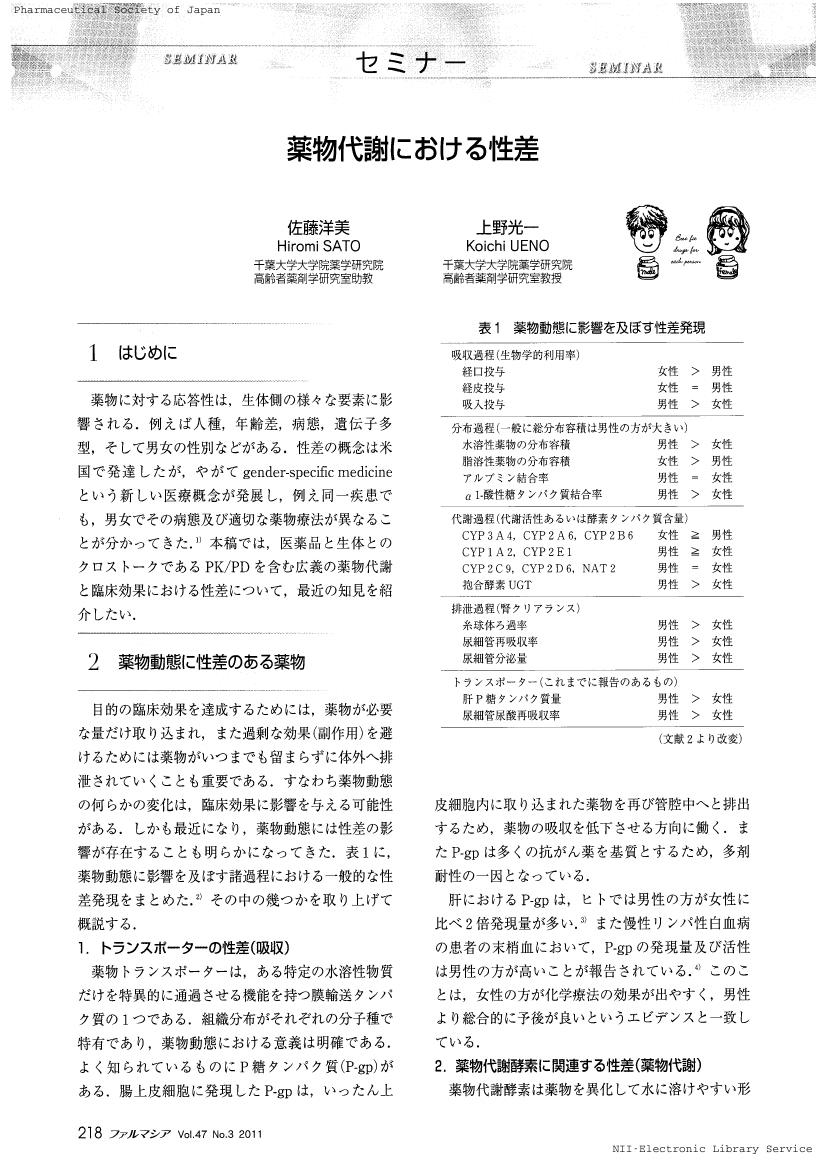5 0 0 0 OA 薬物代謝における性差
- 著者
- 佐藤 洋美 上野 光一
- 出版者
- 公益社団法人 日本薬学会
- 雑誌
- ファルマシア (ISSN:00148601)
- 巻号頁・発行日
- vol.47, no.3, pp.218-222, 2011-03-01 (Released:2017-02-24)
- 被引用文献数
- 1
2 0 0 0 OA 安全な医薬品の開発及び適正使用に関する性差医療研究
- 著者
- 佐藤 洋美 島田 万里江 佐藤 友美 シディグ サーナ 関根 祐子 山浦 克典 上野 光一
- 出版者
- 日本毒性学会
- 雑誌
- 日本毒性学会学術年会 第40回日本毒性学会学術年会
- 巻号頁・発行日
- pp.150526, 2013 (Released:2013-08-14)
【目的】医薬品の中には、対象疾病の受療率に男女差があり、男女のどちらかに偏って使用されるものが少なからず存在する。また、薬物動態や薬効・副作用の発現に性差の存在する薬物も多々存在することが報告されている。そこで、安全な医薬品の開発及び個々人に対する医薬品の適正使用に還元されることを目的として、本検討においては、申請資料概要が提出済みの既承認医薬品の中で、女性が組み込まれている臨床試験を実施したものがどの程度存在するかを調査し、解析を行った。【方法】独立行政法人医薬品医療機器総合機構(Pharmaceuticals and Medical Devices Agency: PMDA)のホームページから検索を行った。2001年4月から2011年12月に承認審査された医薬品のうち、申請資料概要が入手可能な医薬品を対象に調査し、臨床試験における各相の女性の組み込み等について解析を行った。【結果】承認審査された医薬品のうち、国内または海外における第Ⅰ相~Ⅲ相試験及び臨床薬理試験のいずれかには女性は非常に高い割合で組み込まれていた。しかし、第Ⅰ相試験や臨床薬理試験に関しては、女性の組み込み率が低かった。女性を組み込んでいても男女別のデータを区別している医薬品はさらに少なかった。一方、女性が組み込まれ、データを区別している医薬品の添付文書において、性差に関する記述が記載されている医薬品は極めて少なかった。【考察】第Ⅰ相試験や臨床薬理試験の女性の組み込み率が低いことより、薬物動態や薬力学的作用における性差の概念が浸透していないことが考えられた。また、男女のデータを区別している医薬品において、性差に臨床的意義がない場合は添付文書にその旨を記載していないことが多いが、臨床効果に性差がなかったことを記載することは医療現場における安全な医薬品適正使用に貢献すると思われる。
2 0 0 0 薬物代謝における性差
- 著者
- 佐藤 洋美 上野 光一
- 出版者
- 公益社団法人 日本薬学会
- 雑誌
- ファルマシア (ISSN:00148601)
- 巻号頁・発行日
- vol.47, no.3, pp.218-222, 2011
- 参考文献数
- 23
- 著者
- 伊禮 輔 柴田 侑裕 佐藤 洋美 樋坂 章博
- 雑誌
- 日本薬学会第142年会(名古屋)
- 巻号頁・発行日
- 2022-02-01
1 0 0 0 OA 薬物代謝の性差
- 著者
- 佐藤 洋美 上野 光一
- 出版者
- 日本毒性学会
- 雑誌
- 日本毒性学会学術年会 第45回日本毒性学会学術年会
- 巻号頁・発行日
- pp.S20-2, 2018 (Released:2018-08-10)
薬物治療において薬効や副作用に男女差が現れる場合がある。実際には薬力学的および薬物動態学的な発現機構が組み合わさって臨床的性差として現われる。 薬物の体内動態の観点では、薬物の血中濃度は主に分布容積とクリアランスにより決定されるので、分布容積に差を与える要因、すなわち脂肪含量・循環血液量・筋肉量・肺胞面積等の違いや、腎クリアランスが女性で小さいことなどから、一般に女性で血中薬物濃度が高くなりがちである。 薬物代謝の観点では、ヒトの多くの薬物代謝反応に関与するCYP3A4の性差については女性で活性が高いとする報告が比較的多いが、肝臓と小腸で状況は異なる。一方、近年のヒトCYP3A4導入マウスを用いた検討で、雌性マウスにおいて肝臓CYP3A4発現および活性が雄性ラットよりも高いことが示されている。他のCYP分子種の性差も報告されているが、見解が一致するものは少ない。また、薬物の吸収や排泄に影響を与えるトランスポーターの性差もクリアランスに影響を与える要因であるが、薬物排出トランスポーターであるP-gpの性差も示唆されている。 薬理作用の観点では、片方の性で強めに薬効が発現する例として、塩酸ピオグリタゾン、トリアゾラム、SSRIなどは男性に比べて女性で強く現れる。さらに、薬剤性肝障害やアレルギー性皮膚炎も女性に多い。これらの要因には、性ホルモンや免疫機能あるいはセロトニンなどの受容体の性差が関与することが明らかにされつつある。 性差は加齢によって変動する場合もある。加齢による性ホルモン分泌量や生理機能変化の影響は考慮が必要である。動物種間で性差の出方も異なる。どのような人(動物)を対象に、いつ何で観察された事象であるのかも含めて、情報を整理する必要がある。本発表では、薬物動態や代謝に性差の見られる医薬品について、最近の知見も含めて紹介する。
1 0 0 0 OA 腎細胞がん薬物抵抗性とメタボローム変化の連関
- 著者
- 佐藤 洋美
- 出版者
- 公益社団法人 日本薬学会
- 雑誌
- YAKUGAKU ZASSHI (ISSN:00316903)
- 巻号頁・発行日
- vol.140, no.8, pp.963-968, 2020-08-01 (Released:2020-08-01)
- 参考文献数
- 30
Metabolome analysis is an approach to investigate cell characteristics from the metabolites that are constantly produced and changed by those cells. We conducted a metabolome analysis of the response of 786-O renal cell carcinoma (RCC) cells to histone deacetylase (HDAC) inhibitors, which are expected to increase anticancer drug sensitivity, and compared the response with that of drug-resistant cells. Trichostatin A (TSA), an HDAC inhibitor, increased the sensitivity of 786-O cells to sunitinib. Moreover, TCA cycle and nucleotide metabolism of the cells were promoted. The findings that acetylated p53 (active form) and early apoptotic cells were increased suggests that the mechanism involved enhancement of mitochondrial metabolism and function. In addition, established sunitinib-resistant RCC cells were exposed to a combination of sunitinib and TSA, resulting in significant growth inhibition. Principal component analysis revealed that the parent and resistant cells were obviously different, but approximately half their fluctuations were illustrated by the same pathways. In summary, it was suggested that TSA reduced sunitinib resistance by triggering intracellular metabolome shifts in energy metabolism. This was the first recognized mechanism of action of TSA as an HDAC inhibitor.
1 0 0 0 『古今著聞集』巻第五「和歌第六」を読む(4)
- 著者
- 谷 知子 / 久利 若糸 / 佐藤 洋美 / 渡邉 静
- 出版者
- フェリス女学院大学
- 雑誌
- フェリス女学院大学文学部紀要 (ISSN:09165959)
- 巻号頁・発行日
- vol.50, pp.A131-A167, 2015-03
